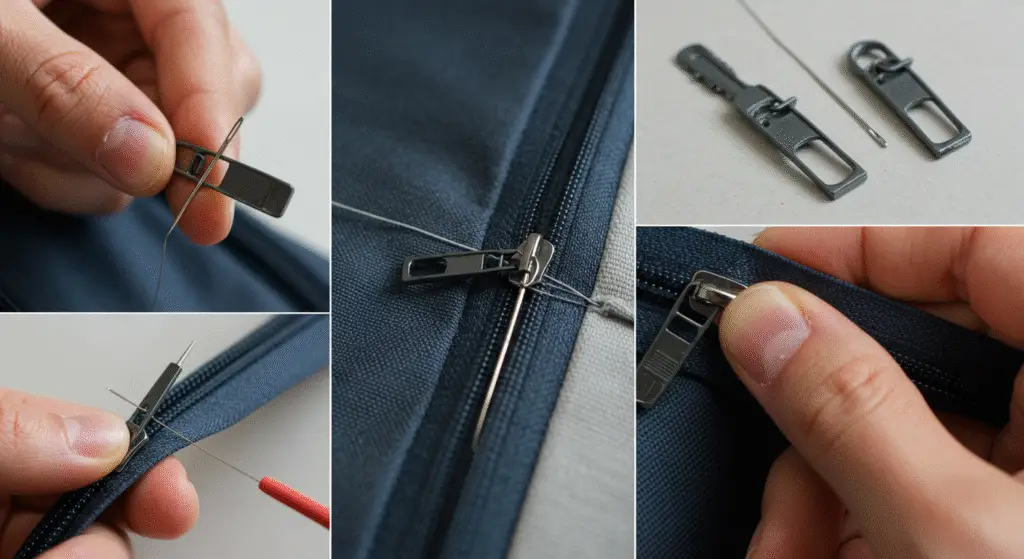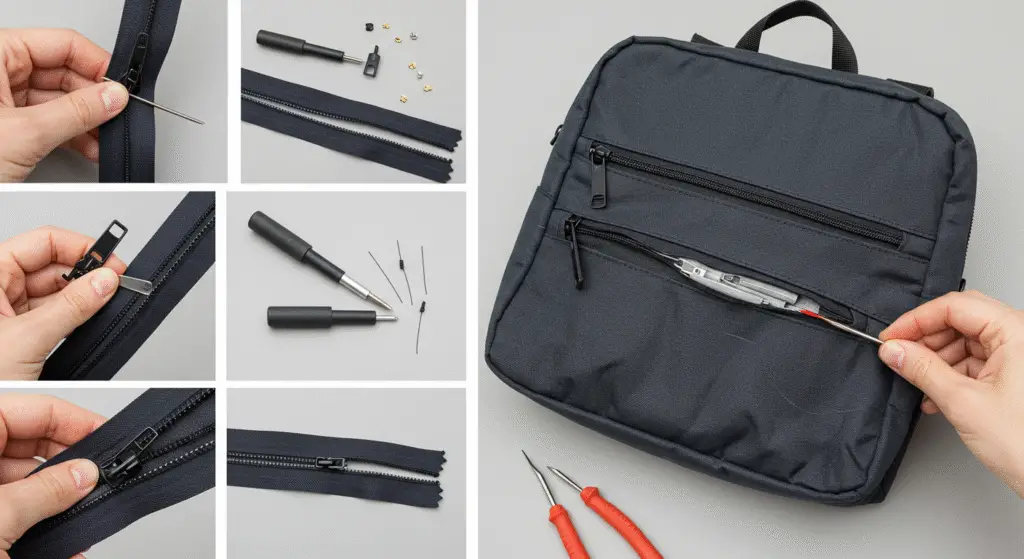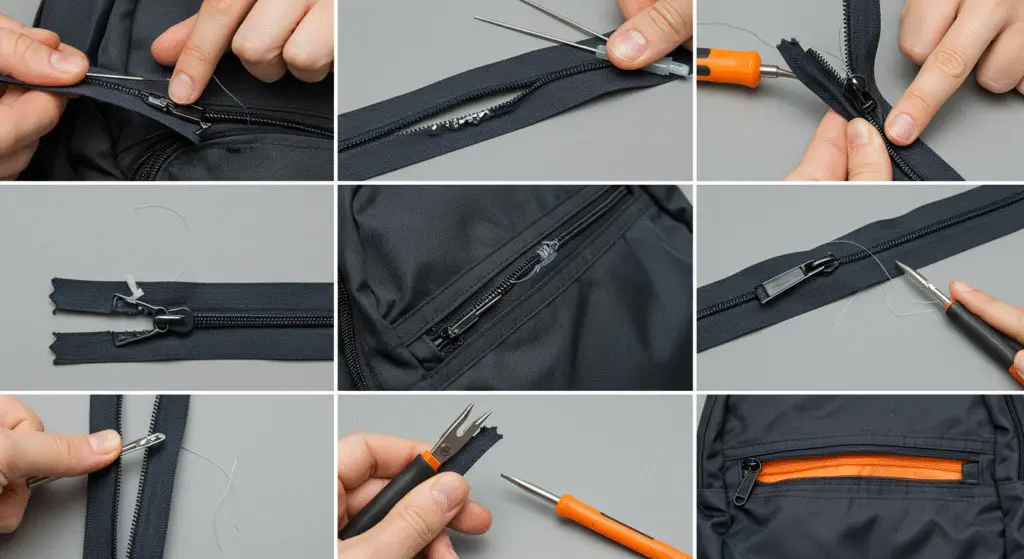
Backpacks go through a lot—whether you’re hauling books, tech, clothes, or hiking gear. And when a zipper suddenly stops working, it feels like the whole bag becomes useless. But before you think about throwing it away or buying a new one, there’s some good news: most zipper problems are completely fixable at home if you know how do you fix a zipper on a backpack.
From stuck sliders to broken teeth, you can solve many common issues using everyday tools and a little patience. If you’re wondering how do you fix a zipper on a backpack without replacing it, this guide will show you simple and effective ways to get your backpack working like new again.
Fixing a Stuck Zipper: Quick Wins You Can Try Right Now
One of the most common problems is a zipper that just won’t move. It feels like it’s caught on something—but there’s nothing in sight. In many cases, a tiny piece of fabric or thread has gotten trapped in the teeth.
Here’s what to do:
- Use a pair of tweezers or a sewing pin to gently pull out any trapped material.
- If it’s still stuck, apply a little lubricant. You don’t need anything fancy—a graphite pencil (just rub it on the teeth), bar soap, candle wax, or even lip balm will work.
- After applying, gently move the slider back and forth to loosen things up.
Tip: Avoid pulling hard! Forcing a stuck zipper can break the slider or misalign the teeth.
What to Do When the Zipper Closes But Splits Open
You zip your backpack up, and everything looks fine—until the zipper starts coming undone from the middle. Frustrating, right?
This usually means your zipper slider has lost its grip.
Here’s how to bring it back to life:
- Use a small pair of pliers to gently pinch the slider. Don’t squeeze too hard—just a little pressure on each side.
- Test the zipper after each adjustment. If it starts closing properly, you’ve fixed it!
Still not working? You might need to replace the slider. You can find affordable zipper repair kits online or at a craft store with everything you need.
When One Side of the Zipper Comes Out Completely
Sometimes the slider slips off one side of the zipper, especially if the stopper at the end has come loose. It looks worse than it is, but the fix is pretty simple.
Steps to follow:
- Use pliers to remove the stopper at the bottom.
- Slide the zipper pull all the way off.
- Reinsert both zipper sides into the pull—make sure they’re aligned evenly.
- Zip it up and down a few times to check.
- Sew a few tight stitches at the end or replace the stopper to prevent it from sliding off again.
This method works great if the teeth themselves are still in good shape.

Dealing With Missing or Damaged Teeth
A zipper with missing teeth can be tricky—but not impossible to manage.
If the damage is near the bottom:
- Simply sew a strong “stop” just above the damaged area. Use a thick thread and go over it a few times.
- This creates a new endpoint for the slider to rest on, bypassing the missing section.
If teeth are missing near the middle or top:
- The zipper might need full replacement, especially if you need it to function smoothly under pressure.
- For a short-term fix, try sewing or gluing the area shut to prevent the slider from reaching it.
Pro tip: Replacing a zipper isn’t as scary as it sounds if you have a basic sewing kit. Plenty of YouTube tutorials can walk you through it.
Home Tools That Make Zipper Fixes Easy
Don’t have a fancy zipper kit? No worries. You can fix most problems using items you already have at home.
Here are a few hacks:
- Pencil (graphite): Works great to unstick a zipper.
- Bar soap or candle wax: Rub gently over the teeth to reduce friction.
- Lip balm or petroleum jelly: A little goes a long way—wipe off excess to avoid mess.
- Pliers: Perfect for tightening sliders or removing/replacing stoppers.
These items make quick fixes easier whether you’re at home, school, or even on the go.
Why the Zipper Won’t Stay Closed and How to Fix It
If your zipper seems to zip up fine but keeps separating, it’s most likely the slider again. This part wears down over time and stops gripping the teeth properly.
You can:
- Tighten the slider slightly using pliers, checking often to avoid damaging it.
- If that doesn’t work, replace it with a matching slider. Most sliders have a number stamped on them—use that to get the right size.
Replacing the slider usually costs less than a coffee and takes about 5–10 minutes. And it can extend the life of your backpack by years.
Making Zipper Repairs Last Longer
Quick fixes are great, but if your backpack sees heavy use, you’ll want your repairs to hold up long-term.
Here’s how:
- Reinforce the zipper base or ends with strong hand stitching.
- Check and clean your zippers occasionally—dust and dirt can make them jam.
- Apply a zipper lubricant every few months to keep things smooth.
- Consider keeping a small repair kit in your travel or hiking bag for emergencies.
Taking a few minutes every now and then to maintain your zippers will save you time, money, and hassle later.

FAQs: What People Ask Most About Backpack Zipper Repair
Can I fix my backpack’s zipper without buying anything?
Yes! A pencil, some soap, or even your fingers can often solve the problem.
How do I know what size slider to buy?
Check the back of your zipper slider—it usually has a small number. That tells you the size.
Is it really worth fixing a zipper?
Definitely. A quick fix can add months or years to your backpack’s life and save you from spending on a new one.
Nothing seems to work—what now?
If DIY solutions don’t help, a tailor or shoe repair shop can usually fix or replace your zipper for a low fee.
Wrap-Up: Don’t Ditch That Backpack Just Yet
Zipper issues are frustrating, but they’re also surprisingly fixable. With a few simple tools and the right technique, you can get your backpack back in action—no sewing degree required.
Whether it’s a stuck slider, broken teeth, or just general wear and tear, you now have a go-to guide for tackling the problem yourself. Plus, fixing it yourself is better for your wallet and the environment.
Next time your backpack zipper gives you trouble, don’t toss it—fix it. You’ve got this.
